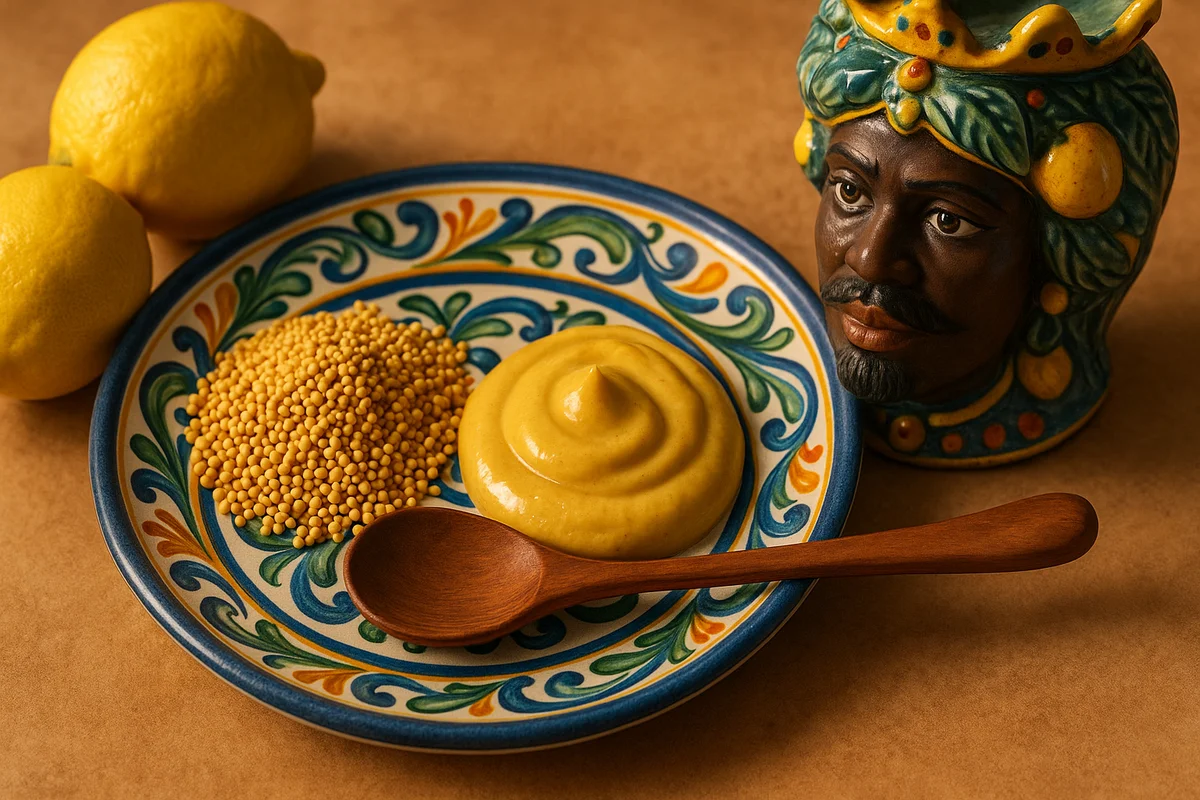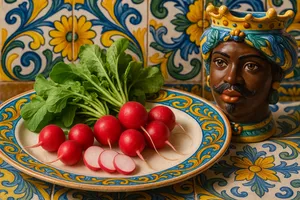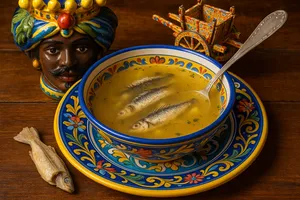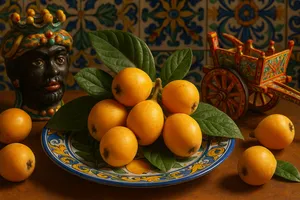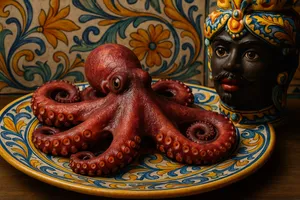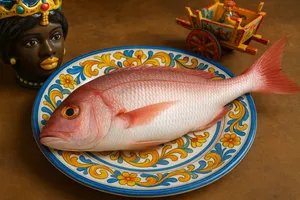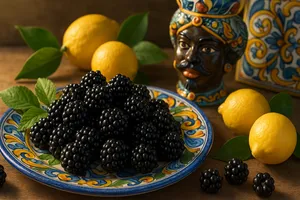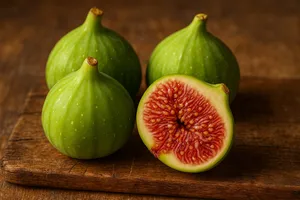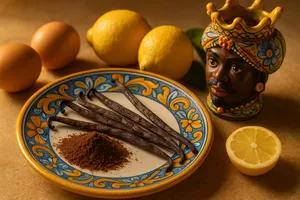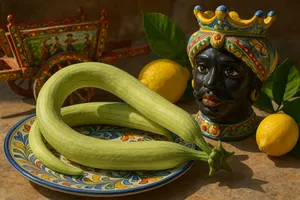Overview
Mustard is a pungent, aromatic condiment obtained by grinding the seeds of plants of the Brassica genus (primarily Brassica nigra, black mustard; Brassica juncea, brown mustard; and Sinapis alba, white or yellow mustard), mixed with liquids (vinegar, wine or water) and aromatics to create a thick paste with its characteristic, sharp flavour. In traditional Sicilian cookery, mustard does not play as central a role as in other culinary traditions (French, German, American), but it is used judiciously in specific preparations: as a condiment for boiled meats, roasts and sausages; in sauces served with smoked or marinated fish; mixed with mayonnaise to enrich it; and in certain modern dishes that blend Sicilian tradition with international influences.
Commercially prepared mustard is available in many variants: mild, hot, wholegrain, smooth, or flavoured. Each type has its own characteristics and uses. In addition to prepared mustard, mustard seeds are used in cookery as a spice: whole in brines, pickles and preserves; ground in spice blends. Mustard plants grow both wild and cultivated in Sicily, with their characteristic yellow flowers colouring the fields in spring. In Sicilian rural tradition, the young leaves of wild mustard (“sinapi di campagna”) were gathered and cooked as a vegetable (similar to turnip tops), testimony to the complete use of the plant. Mustard represents a strong, assertive flavour, a pungency different from chilli (striking the nose more than the mouth), a versatile condiment that elevates otherwise simple dishes.
Characteristics
Mustard seeds are small (1–3 mm in diameter), round, and vary in colour depending on the species: pale yellow (white/yellow mustard), reddish-brown (brown mustard), dark brown to black (black mustard). They have a smooth surface and a hard texture.
The seeds' flavour is initially neutral, but when ground and mixed with liquids, the enzymes (myrosinase) in the seeds react with glucosinolates to form isothiocyanates, volatile compounds responsible for mustard’s characteristic pungency. This pungency differs from that of chilli (caused by capsaicin): mustard produces a sharp, nasal, volatile burn that dissipates quickly.
Prepared mustard (paste or sauce) varies in texture from smooth and creamy to coarse (with whole seeds), in colour from bright yellow to dark brown (depending on the seeds and ingredients), and in flavour from mild to intensely pungent. The aroma is sharp, penetrating and unmistakable.
Types of mustard
American yellow mustard
Made mainly with white/yellow mustard seeds, vinegar, turmeric (which gives its bright yellow colour), sugar and salt. It has a mild flavour, little heat and a smooth texture. It is the classic mustard for hot dogs and hamburgers. Less common in Sicily.
Dijon mustard
French, made with brown or black mustard seeds, white wine (or verjuice) and salt. It has an intense, sharp flavour, a smooth creamy texture and a yellow-brown colour. Versatile and widely used in cookery for sauces and dressings. More common in Sicily than yellow mustard.
Wholegrain mustard
Made with whole seeds not completely ground, vinegar and spices. It has a coarse texture, robust flavour and medium-to-high heat. Appreciated for its distinctive texture. Used with meats, cheeses and dressings.
Sweet mustard
Bavarian sweet mustard, made with seeds, sugar or honey, vinegar and spices. It has a sweet-hot, balanced flavour and a smooth or slightly grainy texture. Served with German sausages and meats.
Hot mustard
Made with black mustard seeds or a mix of hot varieties, little or no sugar, and vinegar. Very intense heat and strong pungency. Used sparingly. Includes English mustard, which is famously powerful.
Italian mostarda
Different from mustard: it is fruit (whole or in pieces) in syrup flavoured with mustard essence. Sweet and pungent, with a fruity texture. Served with boiled meats and cheeses. A speciality of Lombardy (Cremona) but appreciated throughout Italy.
Mustard seeds as a spice
Mustard seeds (yellow, brown, black) are used whole or ground as a spice:
Whole seeds in brines and pickles: They impart a distinctive flavour to pickled cucumbers, marinated vegetables and preserves. A traditional ingredient in giardiniera.
Toasted seeds: In Indian cookery, mustard seeds are toasted in oil until they pop, releasing a nutty aroma. This technique softens the heat and enhances the aromatic notes.
Ground seeds: Mustard powder is added to spice blends, dry rubs for meats and homemade sauces.
Use in Sicilian cookery
Condiment for boiled meats
Mustard (especially Dijon or wholegrain) accompanies boiled meats, mixed boils and tongue. Its pungency contrasts with the delicacy of boiled meats, enhancing them. It is served separately for each person to add as desired.
Condiment for roasts and grills
Mustard spread on meats before cooking (roasts, ribs, chicken) forms a flavourful crust. It can be mixed with honey, herbs and spices for glazes.
Sauces and dressings
Mustard enriches mayonnaise, vinaigrettes and salad dressings. A small amount added to creamy sauces gives depth and liveliness. It is an ingredient in classic sauces such as tartare and remoulade.
Condiment for sausages
Mustard is a traditional accompaniment for sausages, wurstel and hot dogs. In Sicily, grilled sausages served with mustard are appreciated, especially in areas influenced by continental traditions.
Marinades
Mustard is used in marinades for meats (especially pork and rabbit): it tenderises, adds aroma and gives a distinctive flavour.
Condiment for cheeses
Sweet or wholegrain mustard accompanies mature cheeses and mixed cured meat and cheese platters. The sweet-hot contrast enhances flavours.
Homemade mustard
Preparing mustard at home is relatively simple:
Basic Dijon-style mustard:
1. Coarsely grind 100 g of brown mustard seeds (or a mix of brown and yellow) in a mortar or spice grinder.
2. Mix with 100 ml of white wine vinegar, 50 ml of white wine, 1 tablespoon of honey, 1 teaspoon of salt.
3. Leave the mixture covered for 24–48 hours at room temperature (to allow flavours to develop).
4. Blend to the desired texture (smooth or with bits of seed).
5. Adjust salt, vinegar and sugar to taste.
6. Store in a sealed glass jar in the refrigerator.
Homemade mustard keeps for several weeks in the refrigerator. It may be very hot at first, but mellows slightly with time.
Storage
Prepared mustard in a sealed jar keeps for a long time: before opening it lasts 1–2 years in a cool, dark pantry. Once opened, it keeps for several months (6–12 months) in the refrigerator.
Dried mustard seeds keep for 1–2 years in an airtight container, in the dark, in a cool, dry place. They retain their potency when properly stored.
Over time, prepared mustard may darken, separate (liquid and solid parts) or lose heat. It remains safe to consume if properly stored and free of mould.
Buying tips
Select mustard according to its intended use: sweet/mild for children or sensitive palates, medium (Dijon) for versatile uses, hot for strong-flavour enthusiasts, wholegrain for interesting texture.
Read the label: quality mustard has simple ingredients (seeds, vinegar/wine, salt, spices). Avoid products with excessive additives, preservatives or artificial colourings.
Mustard seeds can be bought in spice shops, herbalists and well-stocked supermarkets. Choose organic seeds for the absence of pesticides.
Properties and benefits
Mustard seeds are rich in nutrients: proteins, unsaturated fats, fibre, vitamins (B, C, K), minerals (calcium, magnesium, phosphorus, iron, zinc, selenium). They contain glucosinolates, compounds with antioxidant and anti-inflammatory properties and potential protective effects against certain cancers.
Mustard stimulates digestion, increasing saliva and gastric juices. It has antimicrobial properties (traditionally used in preserves). Its pungent, decongestant effect is appreciated for respiratory relief.
Moderate culinary use is beneficial. Excessive consumption may irritate the stomach and mucous membranes. Mustard is not recommended for those with gastric problems, ulcers or sensitive intestines.
Mustard in tradition
Mustard is an ancient condiment, known to Greeks and Romans. The Romans prepared “mustum ardens” (burning must): grape must mixed with ground mustard seeds, from which the words “mostarda” and “mustard” derive.
In the Middle Ages, mustard was a prized spice used to preserve and flavour meat. The city of Dijon in France developed its celebrated recipe in the 13th century, becoming the world capital of mustard.
In Sicily, mustard does not have as deep a tradition as in northern Europe or France, but it has always been known. The young leaves of wild mustard were gathered as a vegetable (still done in some areas).
Curiosities
The expression “to be a mustard seed” comes from the Gospel parable of the mustard seed, symbol of something tiny that grows enormously. Mustard seeds are small, but the plant grows tall (1–2 metres).
Tear gas derives from mustard isothiocyanates. During the First World War, “mustard gas” (not derived from culinary mustard but chemically related) was a notoriously destructive chemical weapon.
English mustard is famous for its extreme heat. It is said that “English mustard makes even the strong weep”. It is traditional with roast beef.
In some folk traditions, poultices made from mustard flour mixed with hot water were used to treat muscle pain, rheumatism and respiratory congestion. The warming, irritating effect was believed to stimulate circulation.
The mustard plant, with its bright yellow flowers, is beautiful in spring. Fields of flowering mustard are a striking natural sight (especially in France and Canada). In Sicily, wild mustard colours the edges of fields and fallow land.
Mustard seeds are among the most economical yet effective spices: a small amount suffices to flavour dishes. They were (and are) a democratic spice, accessible to all, not reserved for the wealthy like pepper or saffron.
In modern molecular cookery, mustard powder is used as a natural emulsifier to stabilise sauces and vinaigrettes. The lecithins in the seeds help to bind water and oil.

